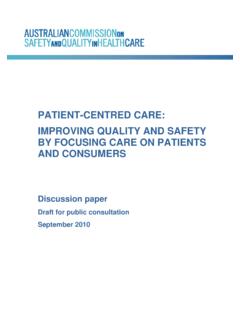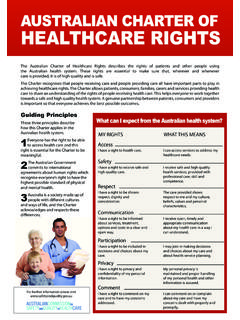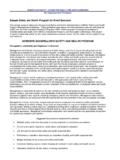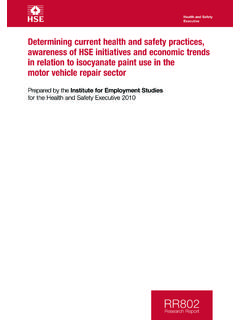Transcription of HEALTH LITERACY: Taking action to improve safety …
1 HEALTH LITERACY: Taking action to improve safety and qualityAugust 2014 Australian Commission on safety and Quality in HEALTH Care HEALTH literacy : Taking action to improve safety and quality Commonwealth of Australia 2014 This work is copyright. It may be reproduced in whole or in part for study or training purposes subject to the inclusion of an acknowledgment of the source. Requests and inquiries concerning reproduction and rights for purposes other than those indicated above require the written permission of the Australian Commission on safety and Quality in HEALTH Care, GPO Box 5480 Sydney NSW 2001 or citationAustralian Commission on safety and Quality in HEALTH Care.
2 HEALTH literacy : Taking action to improve safety and quality. Sydney: ACSQHC, Print: 978-1-921983-61-0 Electronic: 978-1-921983-62-7 AcknowledgmentMany individuals and organisations have freely given their time, expertise and documentation in the development of the paper. In particular, the Commission wishes to thank the HEALTH literacy Advisory Group, those who provided a submission and other key HEALTH literacy experts who have freely given their time and advice. The involvement and willingness of all concerned to share their experience and expertise are greatly of the HEALTH literacy Advisory Committee include Ms Darlene Cox, Ms Maree Cuddihy, Dr Sophie Hill, Ms Lidia Horvat, Dr Anne Johnson, Dr Karen Luxford, Dr Imogen Mitchell, Ms Maureen Robinson, Dr Christine Walker, Ms Diane Webb and Ms Vanessa literacy .
3 Taking action to improve safety and quality1 Executive summary 21 Introduction 4 Purpose 5 Audience 5 Structure 6 Consultation 6 Linking with the National safety and Quality HEALTH Service Standards 6 Part A Background and context 72 What is HEALTH literacy ? 8 Concepts that underlie HEALTH literacy 8 How the Commission defines HEALTH literacy 103 Why is HEALTH literacy important? 12 Evidence about HEALTH literacy and HEALTH outcomes 12 Evidence about HEALTH literacy and safety and quality 14 How is HEALTH literacy linked to outcomes? 14 What are the benefits of HEALTH literacy ?
4 164 How can HEALTH literacy be measured? 18 How is HEALTH literacy measured? 18 The universal precautions approach to HEALTH literacy 215 Where does HEALTH literacy fit in? 22 HEALTH system context 22 Education system context 22 Social, personal and cultural context 23 Related concepts 26 Part B Addressing HEALTH literacy in a coordinated way 296 Addressing HEALTH literacy in a coordinated way 30 The opportunity 30 Addressing HEALTH literacy in a coordinated way in Australia 327 Embedding HEALTH literacy in systems 34 Embedding HEALTH literacy in high-level systems 34 Embedding HEALTH literacy into organisational policies and processes 398 Ensuring effective communication 42 Clear.
5 Focused and useable information about HEALTH and HEALTH care 42 Effective interpersonal communication 509 Integrating HEALTH literacy into education 53 Why provide education to address HEALTH literacy ? 53 Education and training for consumers about HEALTH and HEALTH literacy 54 Education and training for healthcare providers about HEALTH literacy 57 Education and training to improve communication 6010 Who has a role in addressing HEALTH literacy in Australia? 62 Consumers 63 Consumer organisations and other support services 65 Healthcare providers 66 Organisations that provide or support healthcare services at a local level 67 Organisations that support healthcare providers 68 Government organisations, regulators and bodies that advise on or set HEALTH and education policy 69 Private organisations that provide HEALTH -based goods and services 71 Education and training organisations 7211 Where should we go now?
6 74 A systematic approach 74 National, coordinated and collaborative action 75 The Commission s next steps 76 Glossary 77 References 80 Index 90 HEALTH literacy : Taking action to improve safety and quality2 Executive summaryDefinition of HEALTH literacy HEALTH literacy is about how people understand information about HEALTH and HEALTH care, and how they apply that information to their lives, use it to make decisions and act on it.
7 HEALTH literacy is important because it shapes people s HEALTH and the safety and quality of HEALTH Australian Commission on safety and Quality in HEALTH Care (the Commission) separates HEALTH literacy into two components: Individual HEALTH literacy is the skills, knowledge, motivation and capacity of a person to access, understand, appraise and apply information to make effective decisions about HEALTH and HEALTH care and take appropriate action . The HEALTH literacy environment is the infrastructure, policies, processes, materials, people and relationships that make up the HEALTH system and have an impact on the way in which people access, understand, appraise and apply HEALTH -related information and of HEALTH literacyHealth literacy is a significant issue for Australia.
8 HEALTH information and systems have become increasingly complex and harder to understand. Like many other developed countries, almost 60 per cent of adult Australians have low individual HEALTH literacy , which means they may not be able to effectively exercise their choice or voice when making healthcare Low individual HEALTH literacy is associated with higher use of HEALTH services, low levels of knowledge among consumers and poorer HEALTH It has been estimated that people with low individual HEALTH literacy are between one-and-a-half and three times more likely to experience an adverse systematic review that examined the costs associated with low individual HEALTH literacy found that, at a system level, additional costs were equivalent to approximately three to five per cent of total healthcare At an individual level, people with low HEALTH literacy spent between $US143 and $US7798 more per person per year than people with adequate HEALTH literacy .
9 HEALTH literacy is important for consumers because it affects their capacity to make decisions and take action to manage their HEALTH and HEALTH care. It is important for healthcare providers because it affects the way that they manage their relationships with consumers and deliver HEALTH care. It is important for managers and policy makers because the complexity of their systems and services can affect the ability of consumers to use those services effectively. It is also important for broader society because HEALTH literacy contributes to people s overall HEALTH , and consequently their capacity to participate and contribute productively to society.
10 Addressing HEALTH literacy can also contribute to reducing HEALTH disparities and increasing with consumers are essential for both individual HEALTH and HEALTH care and for the development of better healthcare systems. Improving HEALTH literacy ensures that consumers can fully participate in these partnerships, and that the HEALTH system and healthcare organisations are oriented to support such literacy : Taking action to improve safety and quality3 KNOWLEDGE MOTIVATION PARTNERSHIPS INFRASTRUCTURE POLICIES PROCESSES MATERIALS PEOPLE RELATIONSHIPS KNOWLEDGE MOTIVATION PARTNERSHIPS INFRASTRUCTURE POLICIES PROCESSES MATERIALS PEOPLE RELATIONSHIPS KNOWLEDGE MOTIVATION PARTNERSHIPS INFRASTRUCTURE POLICIES PROCESSES MATERIALS PEOPLE RELATIONSHIPS KNOWLEDGE MOTIVATION PARTNERSHIPS INFRASTRUCTURE POLICIES PROCESSES MATERIALS PEOPLE RELATIONSHIPS KNOWLEDGE MOTIVATION PARTNERSHIPS INFRASTRUCTURE POLICIES PROCESSES MATERIALS PEOPLE RELATIONSHIPS KNOWLEDGE MOTIVATION PARTNERSHIPS INFRASTRUCTURE POLICIES
















